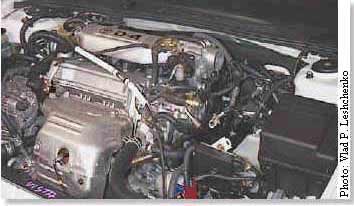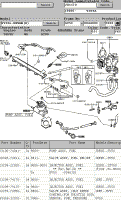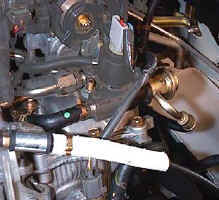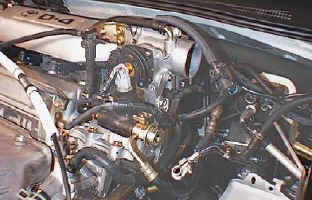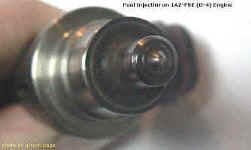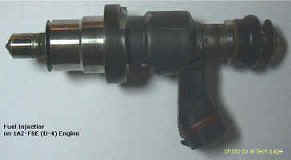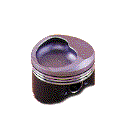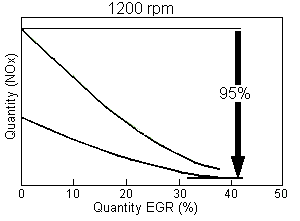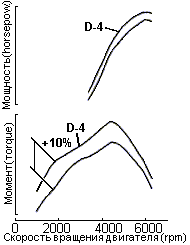cảm ơn các anh (chị) nhiều, các anh chị có thể giúp em dịch tài liệu này để em hiểu rõ hơn được không nhỉ vì tiếng Anh của em rất hạn chế nhưng em lại đang rất cần tài liệu này.
History
Direct Gasoline Injection was introduced on production aircraft during WWII, with both German (Daimler Benz) and Soviet (KB Khimavtomatika) designs. The first automotive direct injection system was developed by Bosch, and was introduced by Goliath and Gutbrod in 1952. The 1955 Mercedes-Benz 300SL, the first sports car to use fuel injection, used direct injection. The Bosch fuel injectors were placed into the bores on the cylinder wall used by the spark plugs in other Mercedes-Benz six-cylinder engines (the spark plugs were relocated to the cylinder head). Later, more mainstream applications of fuel injection favoured less expensive indirect injection methods.
During the late 1970s, the Ford Motor Company developed a s
engine they called "ProCo" (programmed combustion),[1][2] utilizing a unique high pressure pump and direct injectors. One hundred Crown Victoria cars were built at Ford's Atlanta Assembly in Hapeville, Georgia utilizing a ProCo V8 engine. The project was canceled for several reasons; electronic controls, a key element, were in their infancy; pump and injector costs were extremely high; and lean combustion produced nitrogen oxides in excess of near future EPA limits. Also, the three way catalytic converter was proven to be a more cost effective solution.
It was not until 1996 that gasoline direct injection reappeared in the automotive market. Mitsubishi Motors was the first with a GDI engine in the Japanese market Galant/Legnum's 4G93 1.8 L straight-4,[3] which it subsequently brought to Europe in 1997 in the Mitsubishi Carisma,[4] although Europe's high-sulphur fuel led to emissions problems, and fuel efficiency was less than expected.[5] It also developed the first six cylinder GDI powerplant, the 6G74 3.5 L V6, in 1997.[6] Mitsubishi applied this technology widely, producing over one million GDI engines in four families by 2001,[7] PSA Peugeot Citroën and Hyundai Motors both licensed Mitsubishi's GDI technology in 1999, the latter using the first GDI V8.[8][9]
Although other companies have since developed gasoline direct injection engines, GDI (with an uppercase final "I") remains a registered trademark of Mitsubishi Motors.[10]
Renault introduced the 2.0 IDE (Injection Direct Essence) engine in 1999,[11] first on the Renault Megane and later on the Renault Laguna. Rather than following the lean burn approach, Renault's design uses high ratios of exhaust gas recirculation to improve economy at low engine loads, with direct injection allowing the fuel to be concentrated around the spark.[12]
Toyota introduced direct injection engine D4 (Toyota AZ engine) in 2000 Toyota Avensis. Toyota's 2GR-FSE V6 uses a combination of direct and indirect injection. It uses two injectors per cylinder, a traditional port injector and a new direct injector.
PSA Peugeot Citroën introduced their first GDI (HPi) engine in 2000 in the future Citroën C5 and Peugeot 406, a 2.0 litre 16 valve EW10 D unit with 140 hp (104 kW).
Later GDi engines have been tuned and marketed for their high performance. Volkswagen/Audi introduced their GDi engine in 2000 in Volkswagen Lupo, a 1.4 litre 16 valve straight-4 unit with 105 hp (78 kW), under the product name Fuel Stratified Injection (FSI), the technology adapted from Audi's Le Mans prototype race car Audi R8. Volkswagen Group marques uses direct injection in its 2.0 L 16 valve Turbocharged and naturally aspirated four cylinder engines. Later, a 16-valve 2.0 litre straight-4 unit with 150 hp (112 kW), were introduced in the model year 2003 Audi A4.
Alfa Romeo introduced their first direct injection engine JTS (Jet Thrust Stoichiometric) in 2002,[13] and today the technology is used on almost every Alfa Romeo engine.
BMW introduced GDi V12 BMW N73 engine in 2003. This initial BMW system used low-pressure injectors and could not enter lean-burn mode, but the company introduced its s
High Precision Injection system on the updated N52 straight-6 in 2006. This system surpasses many others with a wider envelope of lean-burn time, increasing overall efficiency.[14] PSA is cooperating with BMW on a new line of engines which will make its first appearance in the 2007 MINI Cooper S.
General Motors had planned to produce a full range of GDi engines by 2002, but so far only three such engines have been introduced — in 2004, a 155 hp (116 kW) version of the 2.2 L Ecotec used by the Opel Vectra and Signum. In 2005, a 2.0 L Ecotec with VVT technology for the new Opel GT, Pontiac Solstice GXP, and the Saturn Sky Red Line, and in 2007. The same engine is also used in the Super Sport versions of the Chevrolet Cobalt and the Chevrolet HHR. Also in 2007, the 3.6 L LLT became available in the second generation Cadillac CTS as well as the Cadillac STS.
In 2004 Isuzu Motors produced the first GDi engine sold in a mainstream American vehicle. Standard on the 2004 Axiom and optional on the 2004 Rodeo. Isuzu claimed the benefit of GDi is that the vaporizing fuel has a cooling effect, allowing a higher compression ratio (10.3 to 1 versus 9.1 to 1) that boosts output by 20 hp (15 kW) and that 0-to-60 times drop from 8.9 to just 7.5 seconds, with the quarter-mile being cut from 16.5 to 15.8 seconds.[15]
Mazda uses their own version of direct injection in the Mazdaspeed 6 / Mazda 6 MPS, the CX-7 sport-utility, and the new Mazdaspeed 3. It is referred to as Direct Injection Spark Ignition.
In two-stroke engines
The benefits of direct injection are even more pronounced in two-stroke engines, because it eliminates much of the pollution they cause. In conventional two-strokes, the exhaust and intake ports are both open at the same time, at the bottom of the piston stroke. A large portion of the fuel/air mixture entering the cylinder from the crankcase through the intake ports goes directly out, unburned, through the exhaust port. With direct injection, only air comes from the crankcase, and fuel is not injected until the piston rises and all ports are closed.
Two types of GDI are used in two-strokes: low-pressure air-assisted, and high pressure. The former, developed by Orbital Engine Corporation of Australia (now Orbital Corporation) injects a mixture of fuel and compressed air into the combustion chamber. When the air expands it atomizes the fuel into 8-micrometre droplets, very small relative to the 20 to 30-micrometre fuel droplets in other direct injection systems. The Orbital system is used in motor scooters manufactured by Aprilia, Piaggio, Peugeot and Kymco, in outboard motors manufactured by Mercury and Tohatsu, and in personal watercraft manufactured by Bombardier Recreative Products (BRP).
In the early 1990s, Ficht GmbH of Kirchseeon, Germany developed a high-pressure direct injector for use with two stroke engines. This injector was unique in that it did not require a high pressure pump but was still capable of generating enough pressure to inject into a closed combustion chamber. Outboard Marine Corporation (OMC) licensed the technology in 1995 and introduced it on a production outboard engine in 1996. OMC purchased a controlling interest in Ficht in 1998.[18] Beset by extensive warranty claims for its Ficht outboards and prior and concurrent management-financial problems, OMC declared bankruptcy in December 2000 and the engine manufacturing portion and brands (Evinrude Outboard Motors and Johnson Outboards), including the Ficht technology, were purchased by BRP in 2001.[19][20]
Evinrude introduced the E-Tec system, an improvement to the Ficht fuel injection, in 2003, based on U.S. patent 6,398,511. In 2004, Evinrude received the EPA Clean Air Excellence Award for their outboards utilizing the E-Tec system.[21]
Yamaha also has a high-pressure direct injection (HPDI) system for two-stroke outboards. It differs from the Ficht/E-Tec and Orbital direct injection systems because it uses a separate, belt driven, high pressure, mechanical fuel pump to generate the pressure necessary for injection in a closed chamber. This is similar to most current 4-stroke automotive designs.
EnviroFit, a non-profit corporation sponsored by Colorado State University, has developed direct injection retrofit kits for two-stroke motorcycles in a project to reduce air pollution in Southeast Asia, using technology developed by Orbital Corporation of Australia. The World Health Organization says air pollution in Southeast Asia and the Pacific causes 537,000 premature deaths each year. The 100-million two-stroke taxis and motorcycles in that part of the world are a major cause.



